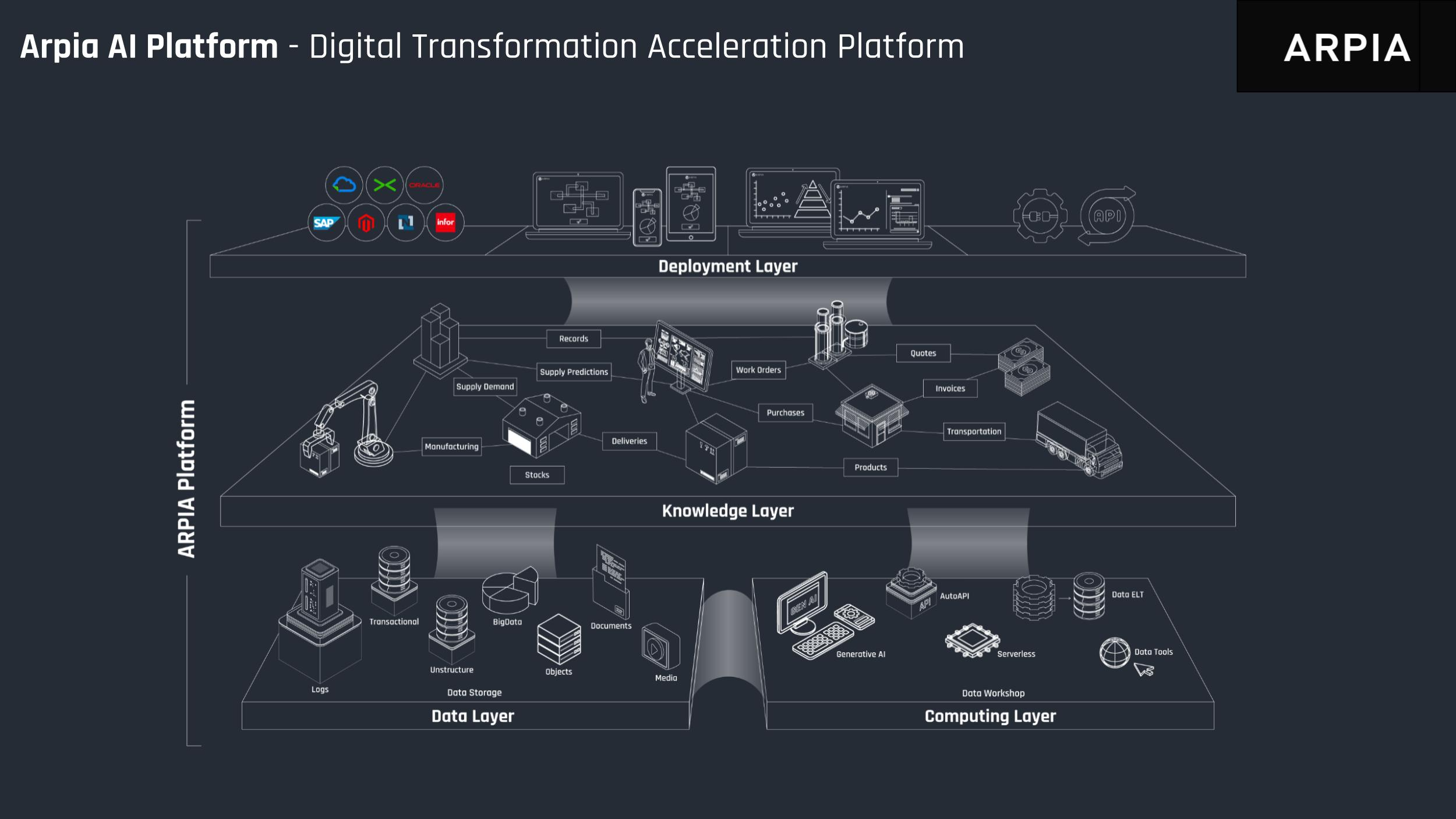ARPIA Platform Key Components

Overview
ARPIA's architecture is built on four fundamental layers that work in harmony to deliver a comprehensive Enterprise AI Platform. Each layer is designed with specific capabilities that contribute to the platform's overall functionality, scalability, and security.
1. Data Layer
Core Purpose
The Data Layer serves as the foundation of the ARPIA platform, managing all aspects of data storage, integration, and access.
Components
Storage Solutions
-
SingleStore
- Purpose: Big data and vertical computing datawarehouse
- Use Cases: High-performance analytics and large-scale data processing
- Features: Vertical scaling, optimized query performance
-
MySQL
- Purpose: Transactional featured database
- Use Cases: OLTP operations, structured data management
- Features: ACID compliance, transactional integrity
-
MariaDB
- Purpose: Full feature database operations
- Use Cases: Enterprise-grade database requirements
- Features: Advanced security, scalability, and plugin support
Object Storage
- S3-compatible APIs
- Scalable document management
- Secure file handling
Data Integration Tools
- Legacy system connectors
- API integration capabilities
- Real-time data synchronization
- ETL/ELT processing
2. Computing Layer (Workshop)
Core Purpose
The Computing Layer handles all processing and computational tasks, providing the necessary resources for AI operations and data processing.
Components
Kubernetes Infrastructure
- Autoscale configuration
- Container orchestration
- Resource management
- High availability setup
AI Processing
- GPU-enabled nodes
- TensorFlow/PyTorch support
- Distributed computing capabilities
Workshop Tools
- AI worker deployment
- Process automation
- Task scheduling
- Resource optimization
3. Knowledge Layer (Knowledge Grid)
Core Purpose
The Knowledge Layer acts as the central intelligence hub, managing information flow and knowledge distribution across the platform.
Components
Knowledge Management
- Centralized knowledge repository
- Semantic search capabilities
- Data governance controls
- Version control
Integration Framework
- Cross-system data mapping
- Unified access protocols
- Data lineage tracking
- Metadata management
Intelligence Features
- Machine learning model management
- Knowledge discovery tools
- Pattern recognition
- Automated insights generation
4. Deployment Layer (AppStudio)
Core Purpose
The Deployment Layer manages the deployment, monitoring, and maintenance of AI applications and services.
Components
Application Management
-
AI App Studio
- Purpose: Build and deploy AI applications
- Features:
- No-Code/Low-Code development
- AI-assisted development
- Visual application design
- Component library
-
AutoAPI
- Purpose: API management and generation
- Features:
- Automated API creation
- Security configuration
- Documentation generation
- Version control
Deployment Tools
- Continuous Integration/Deployment (CI/CD)
- Environment management
- Configuration control
- Release management
Monitoring and Analytics
- Performance monitoring
- Usage analytics
- Error tracking
- Resource utilization
Cross-Layer Integration
ARPIA's Cross-Layer Integration represents a sophisticated orchestration of platform components that ensures seamless communication and data flow across all layers while maintaining robust security and optimal performance. This integration is built on three fundamental pillars:
Security Integration
The platform implements end-to-end encryption across all layers, with unified access control and comprehensive audit logging. This security-first approach ensures that data remains protected as it moves between layers, while maintaining compliance with regulatory requirements and internal governance policies.
Data Flow Management
Inter-layer communication is optimized through intelligent data synchronization and cache management. The platform utilizes load balancing to ensure efficient resource utilization, while maintaining data consistency across all layers. This creates a fluid, responsive system that can handle complex AI operations and data processing tasks.
Unified Management
A centralized administration interface provides comprehensive visibility and control across all layers. This includes monitoring dashboards for performance tracking, configuration management tools for system optimization, and resource allocation controls for efficient operation.
This integrated approach enables organizations to maintain security and efficiency while leveraging the full power of ARPIA's AI capabilities across the entire platform ecosystem.
Security Integration
- End-to-end encryption (When avialable)
- Access control (When avialable)
- Audit logging
- Compliance monitoring
Data Flow
- Inter-layer communication
- Data synchronization
- Cache management
- Load balancing
Management Tools
- Unified administration interface
- Monitoring dashboards
- Configuration management
- Resource allocation
Component Interaction
ARPIA's component interaction framework facilitates seamless communication and data exchange between different parts of the platform, ensuring efficient operation and optimal performance. This sophisticated interaction model enables both synchronous and asynchronous communications, allowing components to operate independently while maintaining system cohesion.
The platform achieves this through a well-defined set of communication protocols, standardized data exchange formats, and robust orchestration mechanisms. These elements work together to create a reliable, scalable, and secure environment for component interactions, supporting everything from simple data transfers to complex AI operations.
Understanding how these protocols implement and manage component interactions is crucial for optimal platform utilization and maintenance. The following sections detail the specific communication protocols and mechanisms that enable this sophisticated interaction model.
Communication Protocols
ARPIA's component interaction is built on a robust foundation of modern communication protocols:
- REST APIs
- Event-driven architecture
- Message queuing
- WebSocket support
Data Exchange
The platform ensures efficient data exchange through:
- Standardized data formats
- Protocol buffers
- Cache mechanisms
- Data validation
Orchestration
- Workflow management
- Service coordination
- Resource scheduling
- Error handling
Best Practices
Implementation Guidelines
- Start with data layer configuration
- Establish computing resources
- Configure knowledge management
- Deploy applications incrementally
Performance Optimization
- Regular monitoring of resource usage
- Cache optimization
- Query performance tuning
- Load balancing configuration
Security Considerations
- Regular security audits
- Access control reviews
- Encryption verification
- Compliance checks
Conclusion
The four layers of ARPIA's architecture work together to provide a comprehensive Enterprise AI Platform that enables organizations to:
- Manage and process data efficiently
- Execute complex AI operations
- Maintain centralized knowledge management
- Deploy and manage AI applications effectively
Each component is designed with scalability, security, and performance in mind, ensuring that the platform can grow and adapt to changing organizational needs while maintaining robust operational capabilities.
Updated 10 months ago
